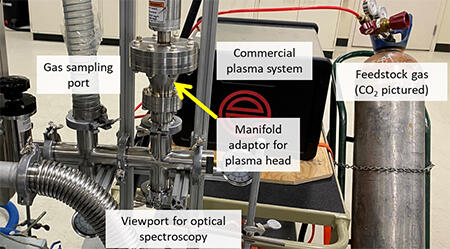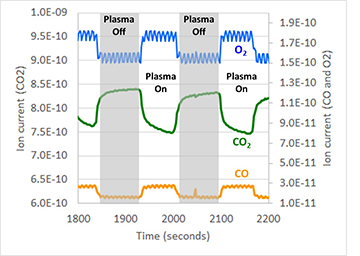Background
The U.S. government has invested more than \$21 billion into industrial decarbonization through the Bipartisan Infrastructure Bill and the International Energy Agency estimates that clean energy investments will reach $4 trillion by 2030. Plasma technology presents an attractive option for industrial decarbonization by enabling the utilization of renewable electricity to drive chemical reactions traditionally fueled by fossil sources. However, the diversity of plasma techniques and reactor variables makes scaling plasma processes expensive and time consuming. There is a need for commercially available plasma systems with demonstrated scalability that can be adapted to the chemistries of industrial decarbonization applications commonly involving methane (CH4) or carbon dioxide (CO2).
Approach

Figure 1: Experimental setup showing custom manifold for commercial plasma system.
The objective of this project was to quantify the intermediate and equilibrium gas species, conversion rates, and energy consumption from CO2 and CH4 plasmas on an industrially scalable platform to assess viability for industrial decarbonization applications. A commercially available atmospheric pressure arc jet plasma system from Enercon Industries Corporation (Blown-Ion™ 125) was used in this project. The system is normally designed to run with a compressed air feed gas but was modified during the project to run with either CO2 or CH4 compressed gas cylinders. A new plasma head adaptor was designed to integrate with a manifold system to enable real time gas composition measurements (Figure 1). Plasma processing variables included anode-to-cathode distance, gas feed flow rate, plasma current, and plasma voltage. Mass spectrometry, gas chromatography, and optical emission spectroscopy were used to characterization of the CO2 and CH4 plasmas.
Accomplishments
This project demonstrated that a scalable, off the-shelf plasma system could operate with gaseous feedstocks (CO2 and CH4) that are attractive for industrial decarbonization applications. Figures 2 and 3 show CO2 and CH4 decomposition when cycling the plasma on and off. The performance of the CO2 and CH4 plasmas are similar to known performance benchmarks, yet this approach has the advantage of pre-established scalability. For example, the CO2 plasma demonstrated a CO2 conversion of 8.6% at a 26% energy efficiency, showing similar performance relative to results published by other researchers (see Figure 4). The methane plasma also performs well compared to state-of-the-art methane pyrolysis processes. At a 14% methane conversion and an energy efficiency of 63%, the plasma process requires 16.5 kWh per kilogram of hydrogen produced. This is very similar to the performance (15 kWh/kg H2) achieved by companies who are commercializing large scale plasma-based methane pyrolysis processes.

Figure 2: CO2 decomposition based on plasma on/off cycles measured by a downstream mass spectrometer.

Figure 3: CH4 decomposition based on plasma on/off cycles measured by a downstream mass spectrometer.

Figure 4: Experimental data from the literature for arc discharge CO2 plasmas. The yellow star shows the performance achieved during this IR&D project.

